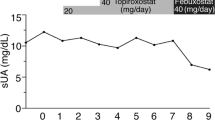Summary
The treatment with pyrazinamide regularly results in a distinct elevation of uric acid levels in serum. This hyperuricaemia is caused by a significant reduction of renal excretion of uric acid. Long-term therapy with pyrazinamide may lead to typical symptoms of gout — in consequence of constant uric acid retention and tissue storage. These symptoms have been described by others, and could be observed by us as well in three instances.
The pyrazinamide-induced hyperuricaemia can be reduced by uricosuric drugs and allopurinol, according to their respective way of action. The implications of these studies are discussed in detail.
Zusammenfassung
Untersuchungen der Beeinflussung des Harnsäurestoffwechsels durch Pyrazinamid ergaben gesetzmäßig bei jedem Probanden eine deutliche Hyperurikämie. Diese wird durch eine statistisch signifikante Verminderung der renalen Harnsäureausscheidung verursacht. Die Pyrazinamidwirkung beruht nicht auf einer toxischen Nierenschädigung, wie durch intensive Prüfung der Nierenleistung gezeigt werden kann. Nach längerdauernder Pyrazinamidgabe können infolge der dauernden Harnsäureretention und-ablagerung im Gewebe die typischen (Gelenk-)Symptome einer Arthritis urica erscheinen, wie an drei eigenen Beobachtungen gezeigt wird. Die Beeinflußbarkeit dieser Symptome sowie der Pyrazinamidbedingten Harnsäureretention und Hyperurikämie durch Gichtmittel wird dargelegt.
Similar content being viewed by others
Literatur
A statement on pyrazinamide. (American Trudeau Society.) Amer. Rev. Tubere.75, 1012 (1957).
Campagna, M.: Observations on the combined use of pyrazinamide and INH in the treatment of pulmonary tuberculosis. Amer. Rev. Tuberc.69, 334 (1954).
Cullen, J. H., L. J. A. Lawrence, andJ. M. Fiore: The occurence of hyperuricemia during pyrazinamide-isoniacid therapy. Amer. Rev. Tuberc.74, 289 (1956).
Davis, B. B., J. B. Field, G. P. Rodnan, andL. H. Kedes: Localization and pyrazinamide inhibition of distal transtubular movement of uric-acid-2-C14 with a modified stop-flow-technique. J. clin. Invest.44, 716 (1965).
Folin, O., andW. Denis: J. biol. Chem.13, 469 (1913).
Frey, J.: Endogene und exogene Clearance der Nieren. Med. Klin.62, 547 (1967).
Gleason, D. F., J. P. Street, andK.-A. Kahn: Effects of pyrazinamide on serum and urine uric acid. Clin. Res. Proc.4, 246.
Heilmeyer, L., u.Krebs: Biochem. Z.223, 365 (1930).
Jungbluth, H., u.H. Martin: Zur uricosurischen Wirkung eines Sulfoxydanalogen des Phenylbutazons. Chemotherapia3, 487 (1961).
Kaplan, K., B. E. Reisberg, andL. Weinstein: Cephaloridine, antimicrobial activity and pharmacological behavior. Amer. J. med. Sci.253, 667 (1967).
Klinenberg, J. R.: The effectiveness of the xanthine oxydase inhibitor allopurinol in the treatment of gout. Ann. int. Med.62, 639 (1965).
Lee, C. C., E. B. Herr, andR. C. Anderson: Pharmacological and toxicological studies on Cephalothin. Clin. Med.70, Heft 6 (1963).
Schneeweiss, J., andG. W. Poole: Hyperuricaemia due to pyrazinamide. Brit. med. J. II, 830 (1960).
Scott, J. T.: Allopurinol in treatment of gout. Brit. med. J. II, 321 (1966).
Shapiro, M.: Hyperuricemia due to pyrazinamide. Amer. J. Med.23, 596 (1957).
Stottmeier, K. D., R. E. Beam, andG. P. Kubica: The absorption and excretion of pyrazinamide. Amer. Rev. resp. Dis.98, 70 (1968).
Tuano, S. B., J. L. Brodie, andW. M. M. Kirby: Cephaloridine versus cephalothin: Relation of the kidney to blood level differences after parenteral administration Antimicrob. Agents Chemother.1966, p. 101.
Yeager, R. L., W. G. C. Munrod, andF. I. Dessau: Pyrazinamide (aldinamide) in the treatment of pulmonary tuberculosis. Amer. Rev. Tuberc.65, 523 (1952).
Yü, T. F., L. Berger, andA. B. Gutman: Supression of tubular secretion of urate by pyrazinamide in the dog. Proc. Soc. exp. Biol. (N.Y.)107, 905 (1961).
—— ——, andA. B. Gutman: Effect of pyrazinamide and pyrazinoic acid on urate clearance and other discrete renal functions. Proc. Soc. exp. Biol. (N.Y.)96, 264 (1957).
Zins, G. R., andI. M. Weiner: Bidirectional urate transport limited to the proximal tubule in dogs. Amer. J. Physiol.215, 411 (1968).
Zöllner, N.: Die Behandlung der Gicht und der Uratnephrolithiasis mit Allopurinol. Verh. Dtsch. Ges. Inn. Med.72, 781 (1966).
Author information
Authors and Affiliations
Rights and permissions
About this article
Cite this article
Kropp, R., Dücker, I. & Schütz, I. Hyperurikämie und Arthritis urica durch Pyrazinamid. Beitr. Klin. Tuberk. 139, 318–325 (1969). https://doi.org/10.1007/BF02090940
Received:
Issue Date:
DOI: https://doi.org/10.1007/BF02090940




